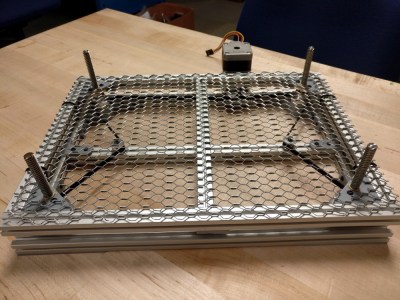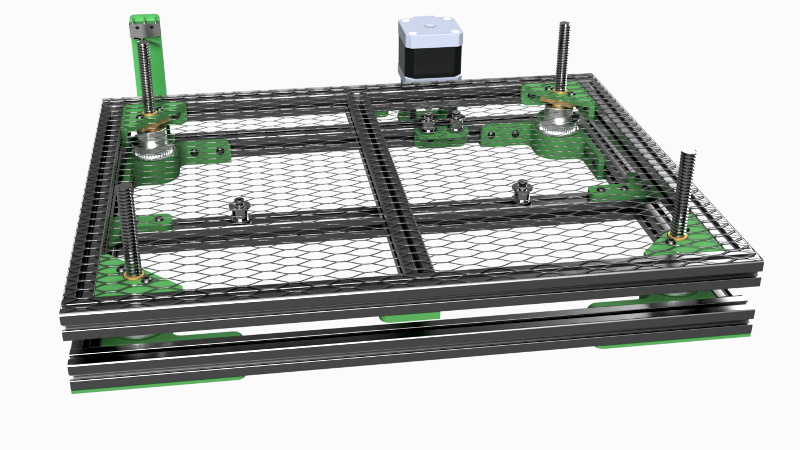If you’ve done even the most cursory research into buying a laser cutter, you’ve certainly heard of the K40. Usually selling for around $400 USD online, the K40 is not so much a single machine as a class of very similar 40 watt CO2 lasers from various Chinese manufacturers. As you might expect, it takes considerable corner cutting to drive the cost down that low, but the K40 is still arguably the most cost-effective way to get a “real” laser cutter into your shop. If you’re willing to do some modifications on the thing, even better.
 One of the shortcomings of the K40 is that it lacks a Z axis, and with thick material that needs multiple cuts at increasingly deeper depths, this can be a hassle. [Aaron Peterson] decided to take it upon himself to design and build an adjustable Z table for the K40 at his local makerspace (River City Labs), and being the swell guy that he is, has made it available under an open source license so the rest of the K40-owning world can benefit from his work.
One of the shortcomings of the K40 is that it lacks a Z axis, and with thick material that needs multiple cuts at increasingly deeper depths, this can be a hassle. [Aaron Peterson] decided to take it upon himself to design and build an adjustable Z table for the K40 at his local makerspace (River City Labs), and being the swell guy that he is, has made it available under an open source license so the rest of the K40-owning world can benefit from his work.
[Aaron] started the design with a number of goals which really helped elevate the project from a one-off hack to a sustainable community project. For one, he only wanted to use easily available commodity hardware to keep the cost down. The most complex components should all be 3D printable so the design would be easy to replicate by others, and finally, he wanted the user to have the ability to scale it in all dimensions. The end result is a electronically controlled lifting platform that anyone can build, for any laser cutter. It doesn’t even have to be limited to laser cutters; if you have a need for precisely raising or lowering something, this design might be exactly what you’re looking for.
The table is primarily constructed out of 15×15 aluminum extrusion, and uses standard hardware store expanded wire mesh as a top surface. Height is adjusted by rotating the four 95 mm T8 leadscrews with a GT2 belt and pulleys, which prevents any corner from getting out of sync with the others. Connected to a standard NEMA 17 stepper motor, this arrangement should easily be capable of sub-millimeter accuracy. It looks as though [Aaron] has left controlling the stepper motor as an exercise for the reader, but an Arduino with a CNC shield would likely be the easiest route.
We’ve seen a lot of hacking around the K40 over the last couple of years, from spring loaded beds to complete rebuilds which are hardly recognizable. If you’re looking for a cheap laser with a huge catalog of possible hacks and modifications, you could do a lot worse than starting with this inexpensive Chinese machine.















What keeps the laser from toasting the drive belt? Is it too out of focus by the time it hits it?
That’s what he was saying on the forum post.
Others were recommending perhaps adding some shielding. You could manage it pretty easily, there’s a lot of room to work with.Some thin sheet metal, bent with a slot to fit the middle bar perhaps.
I was more bothered by the use of galvanized expanding mesh. The reasoning of “I’m venting it anyway so who cares” hurts my brain.
I know that zinc vapor is a health hazard when directly inhaled, but I would not consider it an environmental hazard. At least it IS an essential trace mineral for your body.
Yeah, the galvanized mesh will have some bad off gassing initially when heated up, but the laser should be run with an exhaust vent anyways, so it should be a non issue.
I actually got a lot of feedback on my reddit thread on the belt path, and the feedback seems split down the middle on if the laser will ruin the belt or not. I went ahead and designed some new idler holders and tensioner to get the belt path to go around the perimeter instead of through the middle. It’s a completely optional upgrade now. The new idler holders will actually eliminate the need for the expensive shoulder bolts for the idlers and eliminate the bottom middle extrusion piece. I haven’t uploaded the new models to the repo yet.
Hey Aaron, I really like your design and I am in the midst of a k40 re-re-build at the moment. I’d really like to make this, and it sounds like the second version is a bit simpler. Any update on when you might upload the models? Thanks for your work!
Hey Jason, I don’t normally check this article for updates. Feel free to post a question on the git repo or open an issue for it! I’d be happy to help you out with this!
Exactly, the laser needs to be fairly accurately focused to deliver any power to the surface. That’s one of the reasons people add automatic Z tables to begin with; as you cut deeper into the material you’ll need to raise it up closer to the laser so that it is able make subsequent cuts.
So the belts are far enough away that the laser shouldn’t bother them, plus they would normally be covered by whatever is being cut anyway.
I have black marks on my workbench where the out of focus beam went through the stupid vent hole in the bottom of the metal case. I think it would do some damage to the belts before too long.
I have had the same happened to my worktable I’ve fixed my machine to.
But I’m sure if it poses an issue to the individual who chooses to remake this for themselves, that individual will figure out what to do.
Why do people feel the need to chime in with their opinions on things they haven’t tried like whether or not the laser will harm the belt?
Sure, if two people in a bar were talking about an idea, maybe drawing some designs on a napkin or something their opinions on how it will work might carry equal weight. This isn’t a hypothetical drawn on a bar napkin. This is something somebody actually built. Don’t you think he knows if it worked or not? Don’t you think he knows if the belt was safe, singed or cut? Don’t you think he thought to look for that?
Opinions and guesses have their place but when the hardware has already been built they are as worthless as they are freely given. The only thing of value now is to repeat his build and see if the results are repeatable.
It’s not just a maker thing. Imagine how much better the world would be if people would just realize that their opinions are worthless in the face of observed facts. Politics would be so much better. Religion would pretty much evaporate. Progress would accelerate 1000 fold.
Thanks for your comment since that so typical commentary amazes me all the time. I see that there is a pattern here too: either the article gets flak or just positives depending on the first to comment. That’s I guess typical human nature and where “credibility” comes in. Hackaday stories probably are not held in high regards by some readers and therefore being questioned on the most basic and absurd details. Sure, why would you post a story about something you said you made but actually it was just an idea or not tested? Let’s put the rotten tomato were it belongs, to the thrower: did the people who post their opinions build a project from scratch and publish it? Where is their credibility? Maybe Hackaday should introduce a credibility star rating system based on how many projects and complexity made by the comment poster? (Feel free to look up my projects)
I want to make this gizmo. Have you considered double-start Acme lead screws? When I made my CNC (from purchased plans) I used el cheapo threaded rod instead of precision made Acme screws. It worked but was a little rough. When I make this, I’ll use the Acme stuff. I assume everything I need to know is on the Gitlab repository? Anywhere else? I’m not a big Gitlab user so not sure how to use the site effectively. Is there ONE zip file I can download with all the particulars? I will obtain the STLs from Cults.